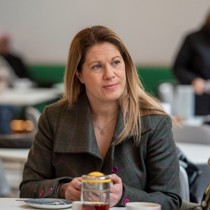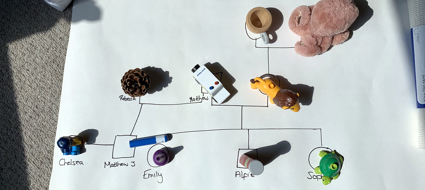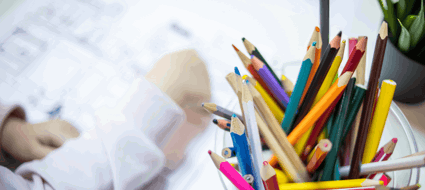The social care profession is built on relationships. We have to utilise relational tools early in our intervention to seek, establish and maintain robust and trusting relationships with the children, young people and adults we support.
One of the greatest assets that a practitioner can rely on to effectively map and understand the social network that our families belong to is the genogram.
Engaging family networks
In the City of Wolverhampton Council, we recognise the value of exploring and engaging wider family networks from an early point. This is to put family support, before formal support, where possible to do so. So, when we became one of the first three local authorities to test out national reforms as part of the Families First for Children Pathfinder pilot, we used this opportunity to build on our strength in this area.
We created a bespoke team of Family Group Decision-makers who would visit families alongside the Family Help Lead Practitioner. This would develop relationships, understand the family’s wider network using genograms and ecomaps which would help us to develop a strong Family Network plan. Our aim is to keep children and families together within their wider family and to strengthen kinship care arrangements. We are really excited about this approach.
In Wolverhampton, as a restorative local authority, we go to great lengths when working with our families to build empowering and respectful relationships that are underpinned by high aspirations and high expectations. When used well, genograms can be the backbone of a person-centred narrative that cathartically explores the rich and diverse kinship network that can surround vulnerable people.
Genograms are also an excellent tool to support our children, young people and their families to give an account of their own childhood. Whilst building the genogram, families are guided with a shared dialogue to create a physical road map, giving relationships colours and signs to portray the physical impact that one person can have on others. This is often seen as a powerful and emotional journey that can lessen the often-stark divide between professionals and the people we work with. It is through this process that the people we are working with stop being an island, cut off from everyone and everything. Genograms allow us to see someone as a sum of all their parts and how they have been formed. A family that was in need of support and intervention was offered the opportunity to complete a genogram to explore the support network and kinship links that could be utilised to strengthen the family as a unit.
Use in practice
During my initial visit to a family* being supported by the Family Help Team due to concerns about home conditions and care of the five children. I explained my role and that our work would include completing an in-depth family genogram that also explored how people treated and interacted with each other in the family.
I asked the mother of the family home to prepare for this by thinking about those in her family and friend network, including different generations. Initially, the mum was reluctant stating that she didn’t speak to her mum and dad so ‘there was no point’. I explained that a genogram would look at so much more than ‘mum and dad’ and would be used to explore her strengths and any areas in her network that she would like support to develop. Following this conversation, she agreed that she would ‘give it a go’ during our next meeting.
On the next visit, unrolling my length of wallpaper across the living room floor whilst holding my coloured pens, drew the attention of the whole family, including the older children. Everyone gathered around and children each chose a coloured pens to draw at either ends of the paper while I sat in the middle of the roll with the mum. I also reassured her that I had made sure that I had the time to fully hear her story, and it was OK to have lots of different feelings whilst completing the genogram.
At first, I paved the way with questions to prompt the mother. She was placed in the centre of the paper and we worked simply and quickly to name family members, noting their date of birth and profession if they had one. She quickly felt able to share her family experiences, talking about her family members which included nephews, nieces and aunts and uncles. As time went on and lines were drawn, anecdotes were added about childhood memories – both positive and negative.
As generations were added of parents and grandparents, colours were used to denote domestic abuse, neglect, substance use and fractured relationships. Close friends were added in and lines drawn to show a tangible connection and a network of support that had yet to be mentioned in previous reports or referrals from different agencies. She was able to safely express her emotions while recounting the distant relationship with her own mother and then again with her grandmother. This was a cathartic experience, one, she told me, she had never spoken before.
Identifying a support network
The genogram highlighted safe people that could offer support when it was needed and potential links that could be strengthened with some help. It was also used as the foundation of safety planning for the eldest child who had been identified as being at risk of exploitation.
Through this work, the mum started to consider the previously declined offer of a family meeting, as the genogram had highlighted that ‘family’ did not have to be limited to ‘mum and dad’ and allowed me to explore exactly how wider family could support her now, and into the future. Whilst completing the genogram, she was able to see the generational trends in relational behaviour that was impacting how she cared for her children. She followed the red lines from grandmother to mother to daughter. This allowed her to reflect on why she parented the way she did and question what she perceived ‘normal’ parenting practice. She then accepted support from the Early Help Team who worked with mum to implement boundaries and healthy routines for all of the children. The family also received additional support from family members that had previously not been involved, meaning that we were able to reduce the amount of our intervention.
Using my prompts and technical organisation on the page, the mum was able to take ownership of her personal story. By creating an emotional space without judgement or shame, this person-centred process of creating the genogram allowed the intervention to be specific and targeted to the individual needs of the family.
*Details of the family have been changed to protect confidentiality.
An updated Practice Tool explores how genograms can be used in direct practice with children, young people and families, both as a tool for direct work and to inform assessment and decision-making.



